-
Facts and Figures
- Social Security Statistics
- Social Media Statistics
- Cell Phone Usage Statistics
- Cryptocurrency Statistics
- White Collar Crime Statistics
- Crowdfunding Statistics
- Branding Statistics
- How Many Emails Are Sent Per Day
- Money Laundering Statistics
- Childcare Availability Statistics
- Cold Calling Statistics
- Automation And Job Loss Statistics
- Student Loan Statistics
- Spam Statistics
- Password Statistics
- Ransomware Statistics
- Christmas Spending Statistics
- Average Grocery Cost By State
- Average Screen Time Statistics
- Average Monthly Expenses
- IoT Statistics
- Gen Z Statistics
Automation has led many Americans to worry about job security, and it’s important to understand where exactly these fears are coming from. After all, not all industries are created equal, with technology replacing human jobs at a much higher rate in some fields. To further understand the impact of artificial intelligence on employment, our data analysis team concluded:
Automation is predicted to displace 20 million manufacturing jobs by 2030.
The US is home to 310,700 industrial robots, and that number increases by at least 40,000 each year.
Automation has the potential to eliminate 73 million US jobs by 2030, which would equate to a staggering 46% of the current jobs.
37% of Americans are worried about automation displacing them from their jobs.
85% of Americans approve of automation only in jobs that are dangerous or unhealthy for humans.
The installation of industrial robots has increased at a 10.28% compound annual growth rate over the past decade.
25% of American jobs are highly susceptible to automation.
Globally, there are 3.5 million operating industrial robots as of 2021 — a 17% increase from 2020.
For further analysis, we broke down the data in the following ways:
Industry | Demographics | Region | Trends + Predictions | Public Opinion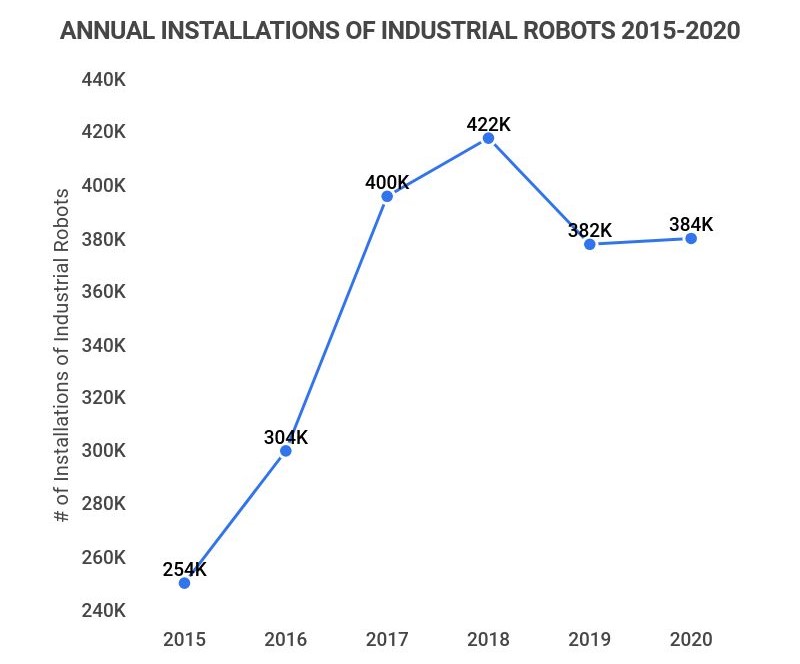
Global annual installation of industrial robots 2015-2021
| Year | New Robots |
|---|---|
| 2015 | 254K |
| 2016 | 304K |
| 2017 | 400K |
| 2018 | 423K |
| 2019 | 391K |
| 2020 | 394K |
| 2021 | 517K |
General automation and job loss statistics
Automation has an impact today, and will continue to affect workers in the future. To understand these effects further, we’ve gathered some general facts about automation. For example, our research has shown that over the next decade, job loss due to automation will become a more pressing issue. Here are other facts:
25% of US jobs are experiencing high levels of disruption due to automation.
36 million US jobs have a high potential for automation, while 52 million American jobs have a medium risk of disruption. 57 million jobs fit into the “low-risk” category, but it’s clear that almost every job will be affected by automation in some way.
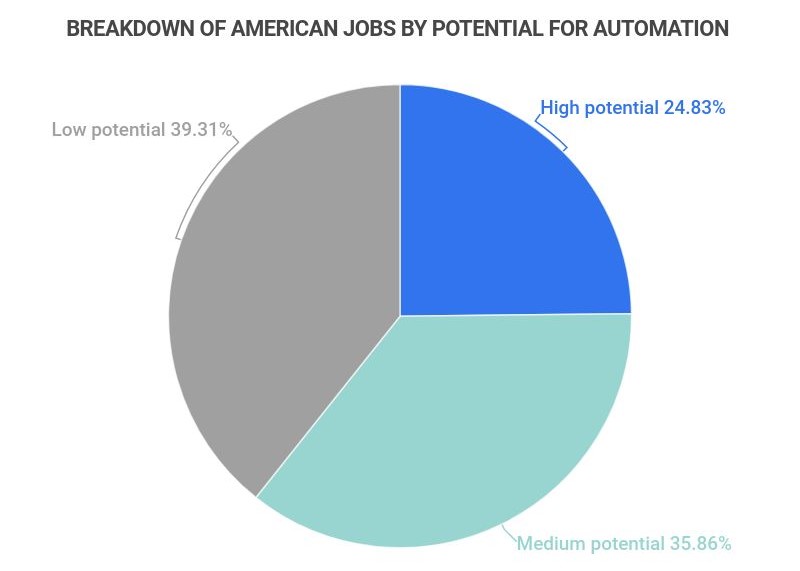
Having a college degree can protect you from job loss by at least 21%.
Estimates show that at least 50% of the work done by those without bachelor’s degrees could be automated with existing technologies. On the other hand, having a college degree reduces that number by 29%.
Since 1990, the cost of employee labor has risen by over 200%. Meanwhile, the cost of robots has dropped by over 50%.
While the cost of labor has risen, the cost of robots has fallen. These compounding factors are a source of anxiety for US manufacturing workers in particular.
The 2022 AI market size in the US alone is valued at over $119 billion.
America’s AI market size sits at $119.78 billion, and this is only expected to increase — significantly. From 2022 to 2030, experts predict an incredible compound annual growth rate (CAGR) of 38.1% for the AI industry.
There are over 310,700 industrial robots in the US, most of which operate in factories.
And that number increases by at least 40,000 or more annually. Further, as many as 46% of these factory jobs will be replaced by this ever-growing number of robots by 2030.
Automation has the potential to raise the United States GDP by 5% within the next five years.
Automation will impact the economy in many ways. Higher productivity will lead to greater GDP, as well as faster economic growth, more consumer spending, and increased labor demand. The GDP is expected to rise by at least 5% as a result of automation, which would equate to a considerable $1.2 trillion.
Since 2000, at least 260,000 jobs have been lost in the US to automation.
This represents roughly 2% of the country’s total manufacturing workforce, and the numbers only increase each year exponentially.
Automation is also predicted to create 58 million new jobs.
Though automation could result in the elimination of 73 million jobs, it’s also predicted to create 58 million new jobs. While a net loss of 15 million isn’t exactly cause for celebration, it does seem more manageable than roughly half of the country’s jobs disappearing.
China installed 268,200 industrial robots in 2021; that’s almost 52% of all new industrial robot installations across the globe for the year.
Overall, Asia accounted for 74% of industrial robot installations in 2021, while the number of new industrial robots in Europe and the US increased by around 24% and 14%, respectively, over 2021.
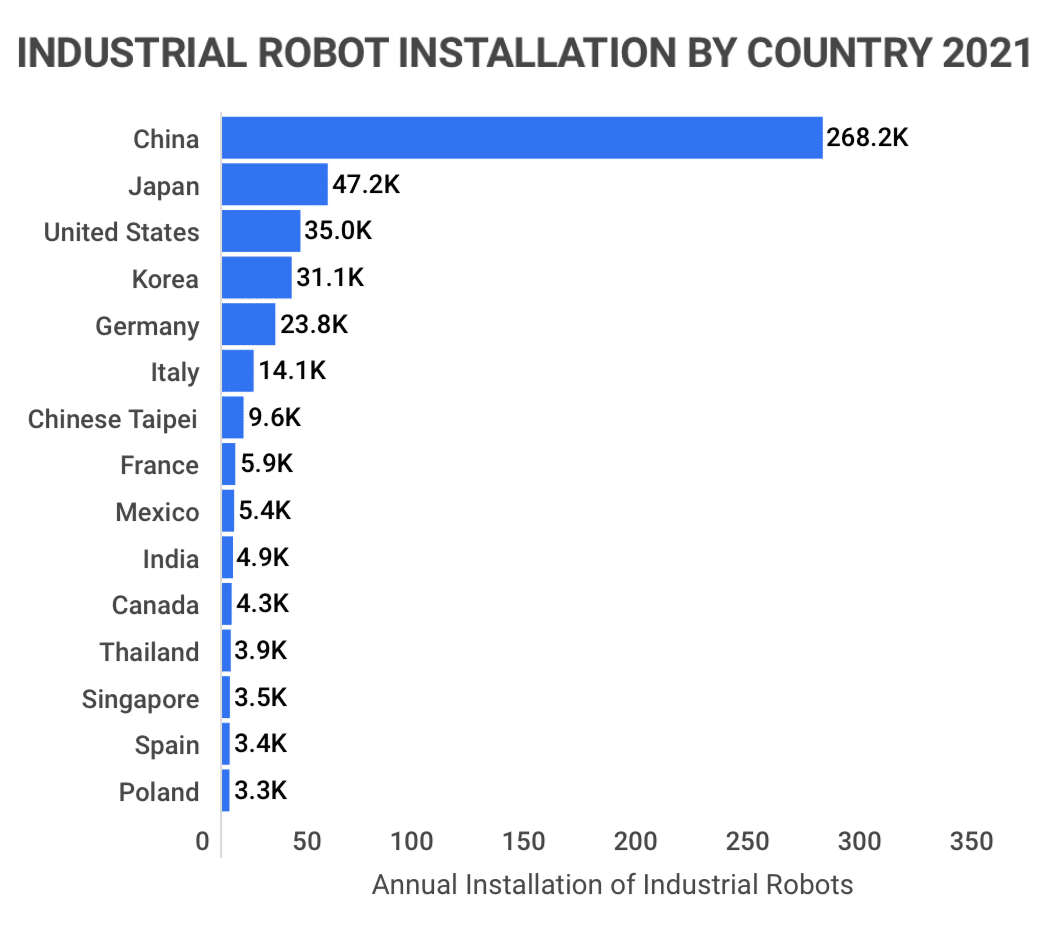
Automation and job loss statistics by industry
Automation per industry varies significantly. By far, most of the robots in the United States operate in manufacturing jobs. By contrast, jobs in education are the least likely to be automated due to complexities associated with teaching, empathy, and more.
Here’s what we found with regards to automation as it relates to certain job industries:
82.3% of industrial robots can be found in the manufacturing industry.
The industries with the highest percentage of robots in use are transportation, manufacturing, metal and electronic, chemical, food and beverage, and wood and paper manufacturing industries.
The Automotive Industry employs 38% of manufacturing robots.
The automotive industry employs a large percentage of manufacturing robots in the US, at a rate of 7.5 robots per 1,000 workers.
Creativity, emotional intelligence, and STEM proficiency are the most important skills to have to avoid job automation.
Many jobs with these qualities fall into the health care, education, and art industries.
Here are the jobs that make at least $75,000 per year with automation risks below 1%: Audiologists, Occupational Therapists, Sales Engineers, Dentists, Medical Scientists, Podiatrists, Education Administrators, Psychologists, Human Resources Managers, Training and Development Managers, Speech-Language Pathologists, Computer Systems Analysts, and Medical Services Managers.
Audiologists and Occupational Therapists have automation risks below 0.40%.
These two jobs have the lowest automation risk for any job that pays at least $75,000 annually. Audiologists only have a 0.33% risk, whereas Occupational Therapists have a 0.35% risk.
Accountants, Inspectors, and Taxi Drivers have an automation risk of 98%.
These jobs currently have the highest automation risk, with Cashiers, Secretaries, Office Clerks, Receptionists, and Restaurant Hosts not far behind.
The US autonomous car market is expected to reach $8 billion by 2026.
Currently valued at roughly $3 billion, the autonomous car market is expected to have a compound annual growth rate (CAGR) of 17% over the next five years. By 2026, the market could increase in value by over $5 billion.
10 jobs with the lowest risk of automation
| Occupation | Automation Risk |
|---|---|
| Occupational Therapist | 0% |
| Music Therapist | 0% |
| Rehabilitation Physician | 0% |
| Physical Education Specialist | 0% |
| Technical Education Teacher | 0% |
| Exercise Physiologist | 0.02% |
| Neuropsychologist | 0.02% |
| Art Therapist | 0.17% |
| Nursing Instructor | 0.19% |
| Podiatrist | 0.34% |
10 jobs with the highest risk of automation
| Occupation | Automation Risk |
|---|---|
| Food Science Technician | 97% |
| Procurement Clerk | 97% |
| Library Technician | 97% |
| Cargo and Freight Agent | 97% |
| Tax Preparer | 97% |
| Real Estate Broker | 96% |
| Counter and Rental Clerk | 96% |
| Agricultural Inspector | 96% |
| Manicurist | 96% |
| Correspondence Clerk | 96% |
Automation and job loss statistics by demographics
Automation is a concern for most Americans, with 76% believing that automation will heighten inequality. With that in mind, it’s important to take a look at how automation will impact different demographics. Here are the facts:
Black and Latino workers are at greater risk of job loss due to automation.
Of the jobs with an automation risk of over 85%, white workers represented 23.03% of the automation risk. Meanwhile, black workers represented 23.91%, and Latino workers a staggering 30.50%.
13% of those aged 18-24 have either lost a job or had pay and hours reduced due to automation.
Those 18-24 represent the age range impacted the most by automation. The number of those who have either lost a job or had pay and hours reduced is 8% higher than those 30-49.
Baby Boomers are 67% more likely to be drawn to jobs with a high risk of automation than Millennials.
Studies show that Baby Boomers are 67% more likely to work in routine manual occupations such as installation maintenance, transportation, and production occupations. All of these jobs are at a much higher risk of automation.
Women face a 10% higher risk of job loss as a result of automation.
When it comes to jobs with potential automation risk, women faced a 33.9% moderate risk of automation, whereas only 24.0% of men did. This can partially be attributed to the fact that 65.2% of men work in jobs with a low risk of automation, compared to only 55.6% of women.
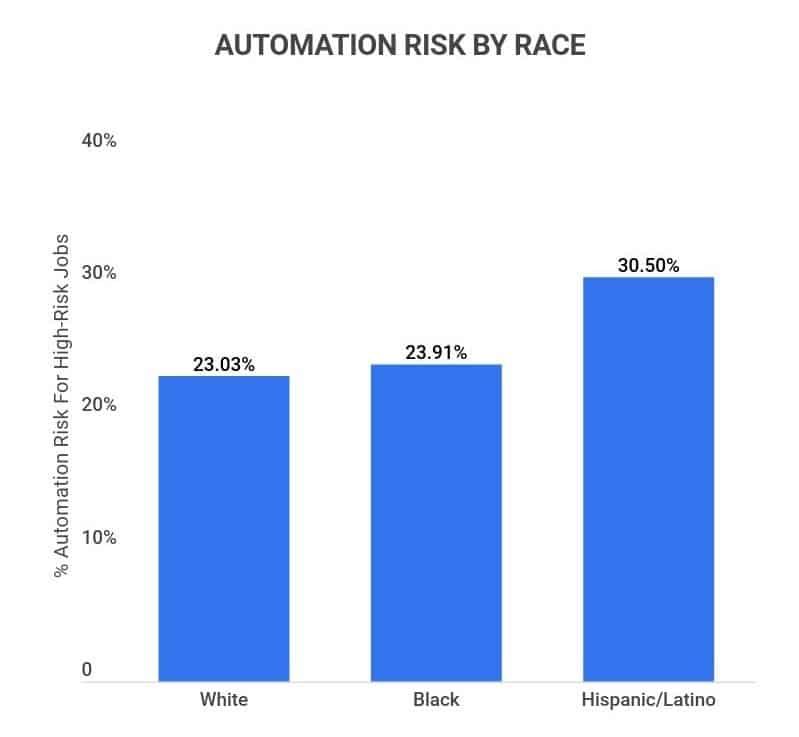
Automation and job loss statistics by region
Automation has a greater effect on cities with a large portion of manufacturing jobs. The states predicted to have the most job loss due to automation are Nevada, South Dakota, Wyoming, Louisiana, Montana, South Carolina, Mississippi, Florida, Texas, and Alabama. Here are the facts:
Between 38-65% of jobs in Nevada have a high risk of being automated.
Southern Nevada (particularly Las Vegas) is currently the region with the highest risk of automation. Within the next decade, between 500,000-860,000 of the 1.3 million jobs in the city could be automated.
LA, Chicago, and Houston are the cities that have the most robots in the workforce.
Los Angeles, California, has 6.91 robots for every 1,000 workers, Chicago has 6.01 per every 1,000 and Houston has 3.38 for every 1,000. By contrast, there are 0.34 robots per every 1,000 human workers nationally.
Automation causes cities to gain jobs, while rural areas lose them.
Over the last decade, urban areas have gained 66% of all job growth; meanwhile, rural areas have been losing thousands of jobs. This is because rural areas tend to have lower-skilled workers, which increases the unemployment ratio by 0.8.
10 US cities with the highest job automation rates
| City/State | Robots Per 1,000 Workers |
|---|---|
| Los Angeles, CA | 6.91 |
| Chicago, IL | 6.02 |
| Houston, TX | 3.38 |
| Phoenix, AZ | 2.16 |
| Detriot, MI | 1.7 |
| Milwaukee, WI | 1.63 |
| Philadelphia, PA | 1.51 |
| San Jose, CA | 1.44 |
| Indianapolis, IN | 1.43 |
| Cleveland, OH | 1.29 |
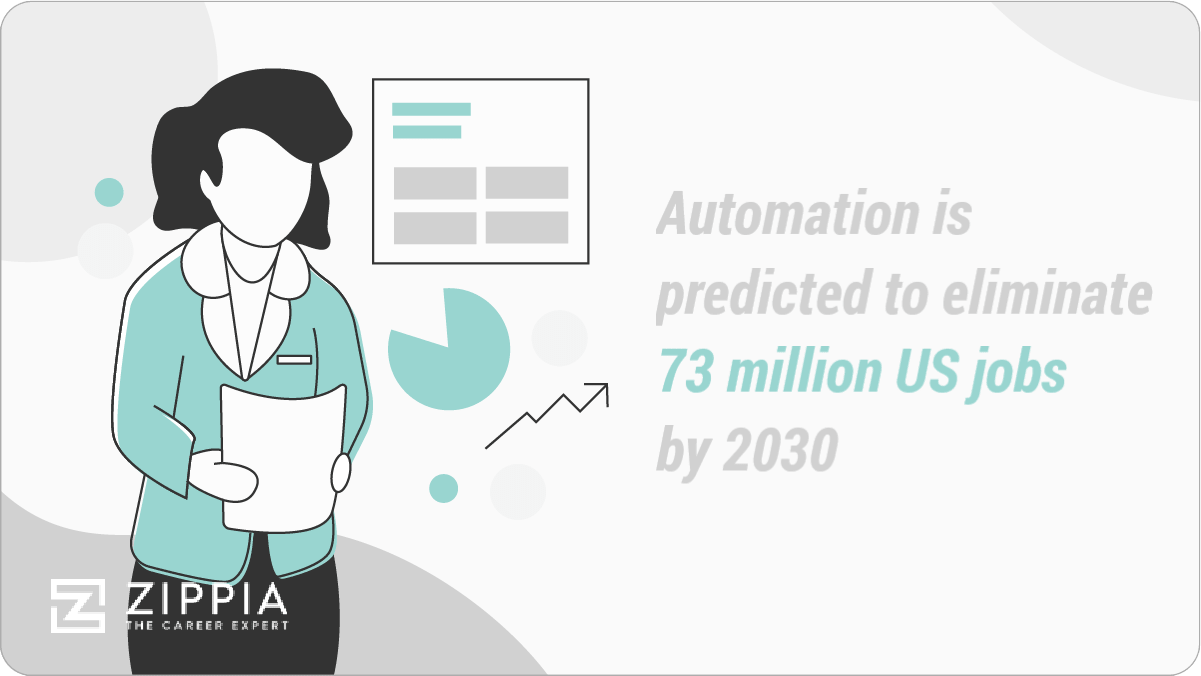
Automation and job loss trends and predictions
We never know what the future truly holds, but when it comes to automation, there are quite a few predictions. Here’s what experts say:
85% of the jobs that will exist in 2030 haven’t been invented yet.
This might be surprising, but just consider the fact that any job involving the modern internet didn’t exist as little as 20 years ago.
Robots complete 29% of task hours today.
Currently, 71% of total current task hours are completed by humans, as opposed to 29% by robots. This number is only expected to increase over time.
Globally, the market for robots is expected to grow by 26% by 2025.
The installation of industrial robots has increased at a 10.28% compound annual growth rate (CAGR) within the past decade, a sign of times to come.
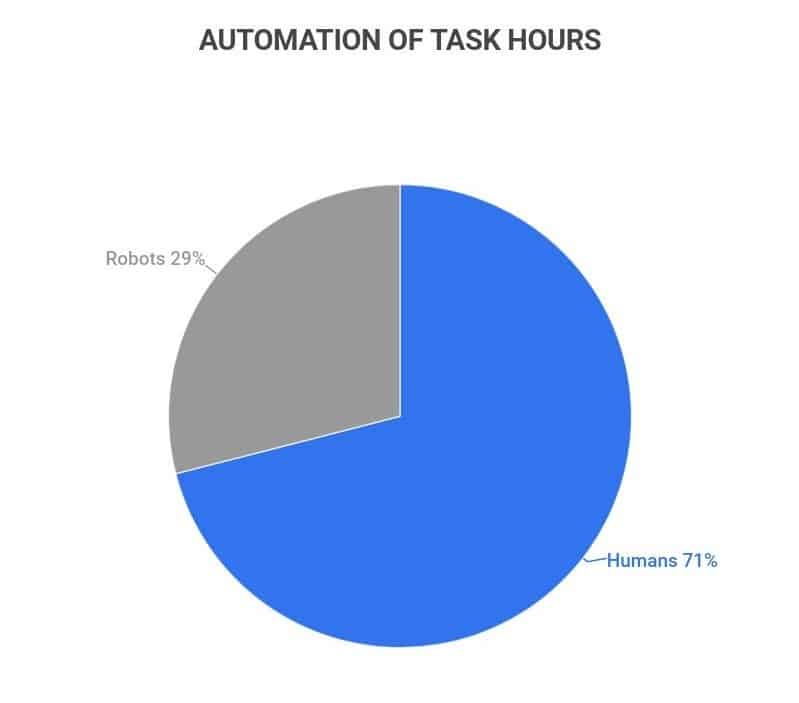
Opinions on job loss and automation statistics
Automation isn’t very popular, with US employees having more negative feelings toward it than positive ones. Many predict job loss, inequality, and other negative results. Here are statistics:
82% of Americans believe that by 2050, much of the work done by humans will instead be done by robots. By the same token, 48% say that these changes will hurt American workers.
37% of American workers fear that automation will affect their own line of work by being able to replace them.
Only 22% of all adults believe that automation has helped US workers.
85% of US employees say that automation in the workforce should be limited to “dangerous and dirty” jobs.
A considerable 74% of Americans believe that fully autonomous vehicles will not be safe. However, 68% also agreed that they would change their mind if the cars had a proven track record of safe use.
Despite the increased impact on younger individuals, only 43% of those aged between 18-49 believe that automation has hurt American workers, as opposed to 55% of those aged above 50. In fact, 13% of those aged between 18-24 have been impacted by automation, compared to only 6% of those aged between 50-64.
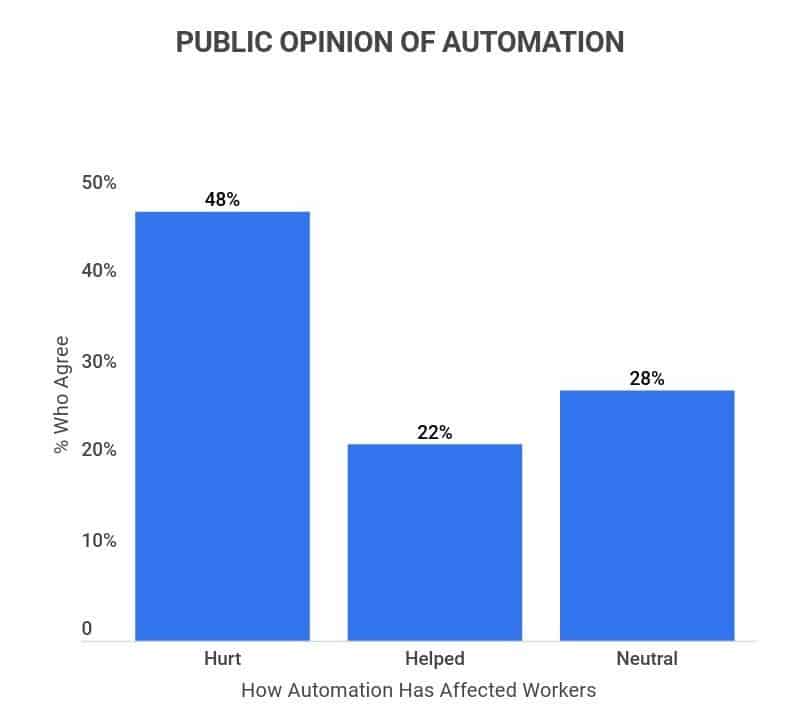
Job loss due to technology statistics FAQ
Should I be afraid of automation?
No, you shouldn’t be afraid of automation. While many of the concerns related to automation and job loss are very real, the American public generally has a more negative opinion of it than is necessary. On the surface, the statistic of 73 million jobs lost to automation seems terrifying, but it ignores the fact that at least 58 million new jobs will be created.
The job market is always changing. It changed rapidly in the past 20 years, and it will continue to change.
How do I avoid losing my job to automation?
To avoid losing your job to automation, there are a few crucial steps you can take. Currently, education plays a vital role in ensuring reduced rates of job loss due to automation. Those with a Bachelor’s Degree or higher are 21% less likely to suffer job loss. Likewise, jobs in health care, education, and the arts are also far less likely to be automated.
Has automation and other technology created or destroyed more jobs?
What percentage of jobs are at risk of automation?
25% of jobs are considered at high risk of being lost due to automation. A further 36% of jobs have medium potential for being automated, meaning they will likely transform significantly or be lost altogether.
39% of jobs have a low risk of automation, however, it’s still very likely that even these jobs will experience many changes over the coming years.
How many jobs will be lost to automation by 2030?
Automation will result in the loss of up to 73 million US jobs by 2030. That’s a considerable 46% of the current jobs, which means automation will no doubt shake up the nature of the job market.
This is especially true for industries and fields that are exceptionally high risk. For example, the manufacturing industry alone is projected to lose up to 20 million jobs by 2030.
Automation and other technology has likely created more jobs than it’s destroyed, although it’s difficult to quantify. Looking forward, the World Economic Forum predicts that by 2025, 97 million new jobs will be created by technology, while 85 million jobs will be lost to automation.
If this prediction holds true, then we will experience a net gain of 12 million jobs, globally, thanks to technological advancements.
Final thoughts
The growth of automation in the workplace will continue to have a profound effect on US workers, the job market, and the economy. While robots are expected to grow in the US GDP by 5% over the next five years, as many as 73 million jobs could be lost.
Additionally, young and minority individuals will be disproportionately impacted. Because of this, it’s unsurprising that many Americans have a negative opinion of automation.
However, not everything is doom and gloom. Automation is also expected to create at least 58 million new jobs, as well as open the doors to 85% of the careers that haven’t been invented yet. At best, robots will allow humans to pursue more innovative, creative, and meaningful careers by ditching the repetitive, mechanical ones.
Sources:
International Federation of Robotics. “Record 2.7 Million Robots Work in Factories Around the Globe’’. Accessed on 8/4/2021
Forbes. “Automation Could Eliminate 73 Million US Jobs By 2030 [Infographic]’’. Accessed on 8/4/2021
US NEWS. “Robots Will Replace 20 Million Jobs by 2030, Oxford Report Finds’’. Accessed on 8/4/2021
Blog trade. “Robots and the Economy: The Role of Automation in Productivity Growth’’. Accessed on 8/4/2021
Education Week. “Automation, Jobs, and Education: 7 Key Takeaways From New Brookings Analysis’’. Accessed on 8/4/2021
McKinsey and Company. “Automation, robotics, and the factory of the future’’. Accessed on 8/4/2021
Statistics Canada. “Automation and the Sexes: Is Job Transformation More Likely Among Women?’’. Accessed on 8/4/2021
Grand View Research. “Artificial Intelligence Market Size, Share Trends Analysis Report’’. Accessed on 8/4/2021
McKinsey and Company. “A FUTURE THAT WORKS: AUTOMATION, EMPLOYMENT, AND PRODUCTIVITY’’. Accessed on 8/4/2021
Leftronic. “Rise Of Robots – Jobs Lost to Automation Statistics in’’. Accessed on 8/4/2021
World Economic Forum. “Here’s why robots are actually going to increase human employment’’. Accessed on 8/4/2021
Pew Research Center. “How Americans see automation and the workplace in 7 charts’’. Accessed on 8/4/2021
Safer Roads. “Public Opinion Polls Show Skepticism About Autonomous Vehicles’’. Accessed on 8/4/2021
MIT Sloan. “A new study measures the actual impact of robots on jobs. It’s significant’’. Accessed on 8/4/2021
Will robots take my job? “Top paid jobs with Lowest Automation Risk’’. Accessed on 8/4/2021
Mordor Intelligence. “UNITED STATES AUTONOMOUS CAR MARKET – GROWTH, TRENDS, COVID-19 IMPACT, AND FORECASTS (2021 – 2026)’’. Accessed on 8/4/2021
Brookings. “Race and Jobs at Risk of Being Automated in the Age of COVID-19’’. Accessed on 8/4/2021
The Nevada Independent. “As more jobs are automated, Las Vegas set to be center stage for economic shifts’’. Accessed on 8/4/2021
CNBC. “The US cities where robots are impacting jobs the most’’. Accessed on 8/4/2021
Inside Sources. “Will Automation Decimate Rural Areas?’’. Accessed on 8/4/2021
Huffington post. “85% Of Jobs That Will Exist In 2030 Haven’t Been Invented Yet: Dell’’. Accessed on 8/4/2021
World Economic Forum. “Machines Will Do More Tasks Than Humans by 2025 but Robot Revolution Will Still Create 58 Million Net New Jobs in Next Five Years’’. Accessed on 8/4/2021
International Federation of Robotics. “IFR presents World Robotics 2021 reports”. Accessed on 1/24/2022.
International Federation of Robotics. “World Robotics Report: ‘All-Time High’ with Half a Million Robots Installed in One Year”. Accessed on 2/14/2023.
Precedence Research. “Artificial Intelligence (AI) Market”. Accessed on 2/14/2023.
-
Facts and Figures
- Social Security Statistics
- Social Media Statistics
- Cell Phone Usage Statistics
- Cryptocurrency Statistics
- White Collar Crime Statistics
- Crowdfunding Statistics
- Branding Statistics
- How Many Emails Are Sent Per Day
- Money Laundering Statistics
- Childcare Availability Statistics
- Cold Calling Statistics
- Automation And Job Loss Statistics
- Student Loan Statistics
- Spam Statistics
- Password Statistics
- Ransomware Statistics
- Christmas Spending Statistics
- Average Grocery Cost By State
- Average Screen Time Statistics
- Average Monthly Expenses
- IoT Statistics
- Gen Z Statistics




